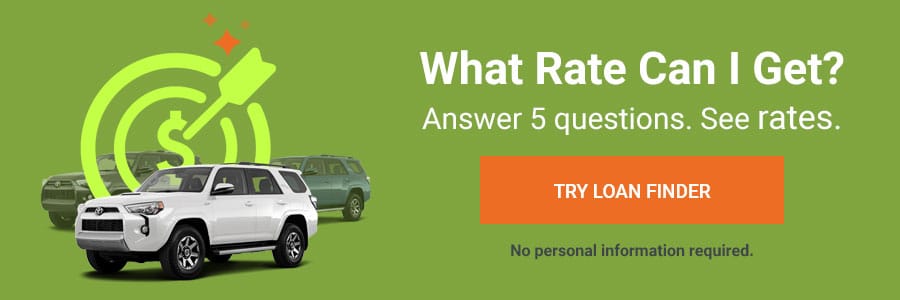Yes, you can trade in an upside-down car. But that doesn’t mean you should.
They say life comes at you fast. Well, so does car depreciation.
The typical new car loses more than 10% of its value in the first month of ownership — and 20% in the first year. After a few years, your car’s value could be worth a fraction of its purchase price. While that’s normal, it can become a problem if you financed your vehicle with an auto loan.
Why? Because if your car depreciates faster than you make car payments, you could have an upside-down car loan.
So, what can you do?
Fortunately, there are several routes you can take to improve your financial situation. But, first, it’s important to understand upside-down car loans and how borrowers often find themselves in this situation.
What Is an Upside-Down Car Loan?
An upside-down car loan simply means the loan cost is worth more than the value of the car. In other words, your loan balance is higher than how much you could realistically sell your car for. This is also referred to as negative equity — if you sold your car and applied the proceeds to your loan, you would still owe money to your lender.
The easiest way to see if you’re upside down on your car loan is to calculate your loan-to-value ratio (LTV). Your LTV, which is expressed as a percentage, compares your loan amount to the value of your vehicle. If your LTV is above 100%, then you have an upside-down loan. If your LTV is below 100%, then you have some positive equity in your car — if you sold it, you’d pay off your loan and have money left over.
Car (LTV) Loan-to-Value Calculator
A loan-to-value ratio over 100% means you owe more on your loan than your vehicle is worth. An LTV over 125% can make it harder, but not impossible, to qualify for a refinance loan.
If your LTV is less than 100%, your car's value is higher than what you owe on your loan. The lower your LTV, the better.
It’s not uncommon for borrowers to become upside-down on their car loans, especially for people who could only afford a small down payment. Depreciation usually plays a role since most vehicles lose value over time. If your car depreciates faster than you repay your loan, you could wind up with a negative LTV. Similarly, high interest rate loans are a factor too, since they’re harder to pay off ahead of schedule.
Whatever the reason, having an upside-down car is far from ideal. So, if you’re considering trading it in, here are your options.
What Happens When You Trade in an Upside-Down Car?
No one wants to have a vehicle with negative equity. But what can you do to fix it? One option is trading it into a dealership. Let’s walk through four trade-in situations to help you determine the best avenue.
Trading in your upside-down car to a dealer
If you have the flexibility to work remotely or you can rely on other forms of transportation, you might be able to do without your car. Perhaps you can share a vehicle with your spouse or significant other. Regardless, one way to offload an upside-down car is to trade it into a dealership.
Negative equity means you’re in the hole — so, if you trade in an upside-down car, you’re on the hook for the “negative” amount of equity. In other words, you’ll still owe money to the dealer.
For example, let’s assume your car loan’s outstanding balance is $20,000 but your vehicle’s value is estimated to be $17,000. To trade in your car, you’ll have to pay the dealer the difference: $3,000. If you have the liquidity to afford it — and you don’t need a vehicle — this can be a good option for getting out of debt.
Rolling your existing loan into a cheaper car
When you trade in a car to a dealer and pay off the remaining balance, you’re off the hook financially. But you’re also left without a car. Although public transit and ridesharing are common alternatives, you might still want your own ride.
In that case, it’s not uncommon for people to trade in for a used car. You can roll your negative equity into a smaller loan with, ideally, a lower monthly payment. In turn, you’ll have more money to apply to your outstanding balance.
However, this approach is not a recommended solution because your new loan is immediately upside-down. You aren’t erasing the negative equity.
Keep in mind, by rolling your loan into a cheaper car, you’re also extending your loan’s term. The longer your loan term, the more time your next car has to depreciate while you still owe money. If you don’t proactively repay your new car loan ahead of schedule, you could dig yourself into a worse financial hole.
Rolling your negative equity into a lease
You also have the option of rolling your negative equity into a lease — rather than another loan. In case you’re unfamiliar, leasing a vehicle is akin to renting instead of owning a house. You don’t own a leased vehicle, you’re borrowing it for a set period of time. Leases remove the burden of resale once the lease matures.
You hand the keys back to the dealer and it’s no longer your problem.
Compared to rolling a loan into a new vehicle, the primary benefit of leasing is the same: lower monthly loan payments. However, you’re still responsible for the negative equity, which would be accounted for in the cost of the new lease.
Trading in with dealer incentives
Although it’s becoming less common, borrowers can also try to find vehicles with dealer incentives to reduce their negative equity. Sometimes, dealerships promote their inventory by offering significant discounts off sticker prices or cash rebates for a limited time. Dealerships are more likely to employ this tactic toward the end of the year before the next lineup of models launches.
If you’re able to find a good opportunity, you could trade in your current vehicle for a discounted model. Since you’re getting a lower price on a car relative to its market value, your savings may offset some, or all, of your negative equity. You can use sites like Edmunds and Kelley Blue Book to estimate the market value of a vehicle compared to a car dealer’s discount.
However, dealerships aren’t the only ones who might consider buying your car.
Trading vs. Selling Your Upside-Down Car
You can also try to sell an upside-down car to a private party. While negative equity isn’t exactly a selling point, you might still be able to find interested car buyers.
In terms of convenience, it’s much easier to trade in your car to a dealership. They handle the paperwork for you — all you have to do is show up and agree on a value. However, that comes at a cost. Most of the time, the trade-in value of your car is less than what you could sell it for on the market. That’s because dealerships typically offer a price close to your vehicle’s wholesale value, which is lower than its retail value.
If you’re willing to take on the challenge of selling your vehicle privately, you could reasonably expect to get a better offer from an individual buyer. But the trade-offs are convenience and time.
You have to find prospective buyers, which can include: paying for advertisements, fielding phone calls or emails, and scheduling test drives. Plus, the added inconvenience of having to go through your lender since you’d still owe them money and they likely hold the title. But, if you have the time and previous experience selling vehicles, selling your car to a private party could be an effective way to minimize your negative equity.
An Alternative to Trading In Your Upside-Down Car: Refinancing
You don’t necessarily have to hand over your keys to improve your LTV. According to the RateGenius 2022 State of Auto Refinance report, approved borrowers shaved their interest rate by 5.5% on average. This helped the average borrower save about $990 on an annual basis. Now, imagine if you applied these savings to your loan.
Refinancing can help you land a lower interest rate and, in turn, a lower monthly payment. Then you could apply the cost savings to your existing loan and improve your LTV. And, of course, you get to keep your car.
Refinancing is a good alternative if one or more of the following situations applies to you:
- Your current loan has a high interest rate.
- You had bad credit when you took out your existing loan, but it has since improved.
- You aren’t pressed to sell your car.
Although refinancing can help borrowers get better interest rates and save money, it’s not always the best route if your car loan is upside-down.


When Is Refinancing an Upside-Down Car Loan a Bad Decision?
For starters, you have to qualify for auto loan refinancing. While you can still qualify with an upside-down loan, it’ll depend on your lender’s preferences and the other areas of your financial profile.
According to RateGenius data from 2015 to 2019, approximately 90% of approved refinance loan applicants had an LTV of 123% or lower. So, if your LTV is higher, you might have a harder time qualifying. That said, a strong credit score or debt-to-income ratio could help you offset a high LTV.
Also, if you’re set on trading in your vehicle and have the liquidity to pay off the negative equity, then it might make more sense to start fresh with another vehicle instead of refinancing.
3 Tips for Building Positive Equity in Your Car
You can trade in an upside-down car. You can also refinance an upside-down car loan. But these aren’t your only options. Reducing your loan payoff will improve your LTV and build positive equity in your car. Here are a few tips to get started.
1. Get a part-time job or side hustle
Not everyone has the time or energy to get a part-time job — that’s understandable. However, if you have a few hours to spare each week, another source of income can help you make extra payments. A little extra money in goes a long way to paying off a loan.
2. Cut back on unnecessary expenses
While we can’t give ourselves a raise, we do control our spending habits. Freeing up some of your income by cutting back on “want” purchases can help you pay off your loan faster. There are plenty of budgeting apps and templates you can use to identify areas of overspending or unnecessary expenses.
3. Use cash windfalls responsibly
Every now and then, we benefit from unexpected financial fortune. A spot bonus for going the extra mile at work. A generous cash gift from a relative for a birthday present. An unexpected tax return. While you can’t necessarily predict our next monetary windfall, you can be prepared to use it responsibly.
If you have negative equity in your car and you happen to receive a little extra cash, consider using it to pay down your loan.
More Debt Is Not a Good Fix For Negative Equity
If you’re really scrambling, you might be tempted to take out a personal loan or open a credit card with a temporary zero-interest promotion and use it to pay off some of your auto loan. While this technically reduces your negative equity, it doesn’t fix your debt situation. Taking this route is more likely to hurt you later on, so focus on the other alternative we’ve outlined instead.
About The Author
Jeff Hutcheson is the Co-Founder and Co-CEO at The Savings Group and has been working in the auto finance industry for 24 years. After receiving a BS in Finance and MBA from the University of Colorado, he began his career managing automobile loan portfolios and creating portfolio management and liquidity strategies for and with financial institutions around the country.
;)



